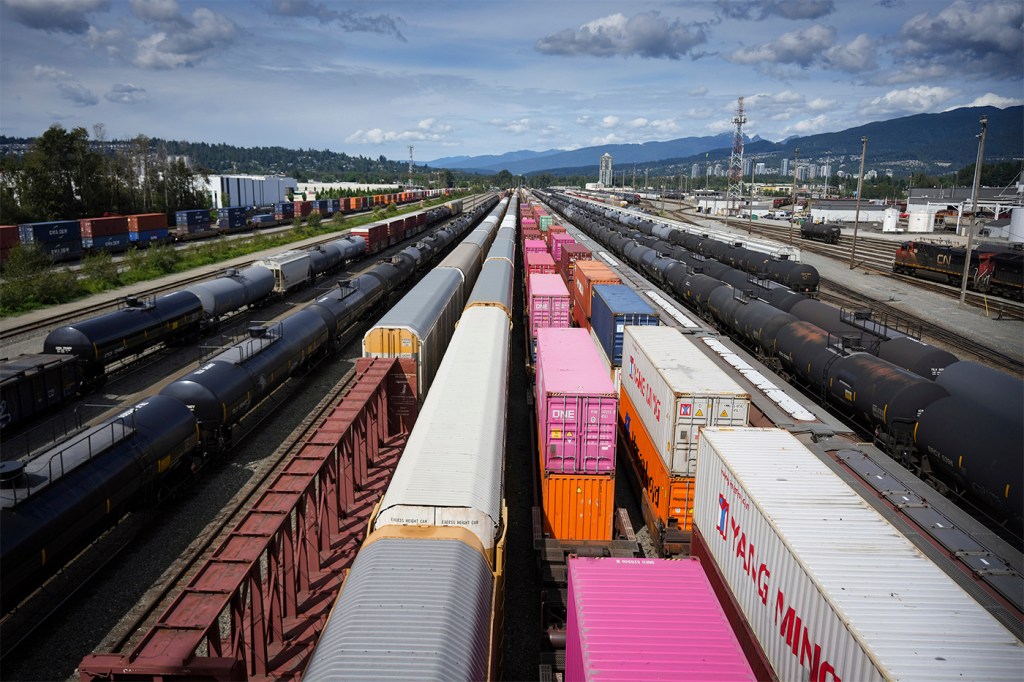Canadian rail shutdown could have ‘devastating’ impact on supply chain, expert says
“This is going to impact the Canadian economy rapidly, and the U.S. economy going into Mexico,” Northeastern distinguished professor Nada Sanders says.

Canadian freight has come to a complete standstill after the two largest freight operators in that country failed to reach a deal with union workers over a labor contract.
Those freight companies, Canadian National and Canadian Pacific Kansas City, locked out thousands of workers — engineers, conductors and dispatchers — affiliated with the Teamsters Canada Rail Conference when an agreement couldn’t be reached before a Thursday deadline.
Now, the concern shifts to the economic impact such a shutdown might have on the interlinking economies of North America.
“This is going to impact the Canadian economy rapidly, and the U.S. economy going into Mexico,” says Nada Sanders, distinguished professor of supply-chain management at Northeastern. “And it’s coming at a time when we’re already grappling with inflation and the cost of food items. It could be bad.”
Northeastern Global News sat down with Sanders to discuss the situation. Her comments have been edited for brevity and clarity.

We’ve all grown accustomed to hearing about supply chain disruptions these days. But this sounds like it could be really bad for the North American economies. If this isn’t resolved in a timely manner, what are the potential consequences?
This is potentially really devastating for, not just the Canadian economy, of course, but for North America more broadly. We’re talking about billions of dollars of goods that are moved daily between both rail systems. Just to illustrate this — there has been some discussion about trucking as a potential solution. Well, it would take about 300 trucks to transport what a single rail train can contain. So this could potentially be really, really bad because there would be a huge cascading effect.
When you look at all those goods — from lumber to auto parts to fertilizer — and the way they are moved, you end up getting this massive backlog. Obviously that impacts manufacturing plants, and I have no doubt that many of them are planning for the possibility that this could be a prolonged situation. So if I’m running a manufacturing plant, what does that mean? I would have to be very strategic in terms of what I am producing. That means potentially scaling back production and investing in a little bit more backup inventory.
When we talk about supply chain disruptions, we’re usually referring to a whole system that connects suppliers, retailers and consumers. Can you give us a sense of the scale of the supply chains affected in this case?
Absolutely, and that is the way that everyone needs to look at it. That’s where the problem comes in — and where the complexity comes in. If you look at just one point along the chain, that’s too simplistic. You have to understand that it’s this massive network. In the U.S., this system is going all the way to the Gulf of Mexico, and you’ve also got traffic going the other way too. It’s bidirectional. Then it feeds into cargo ships and trucks and factories and storage containers and distribution centers all across the continent — all of it contingent on the flow of materials and goods from some other point in the chain.
Featured Posts
Most of these products — because of the kinds of containers that they’re in — can’t be easily moved into trucks. So even if we did have the truck capacity — which we simply don’t, if you look at the numbers — when you look at, say, fertilizer and paint, there are all sorts of different container requirements. You’ve got coal and grains. You’ve got chemicals that could be toxic. It’s a very complex what we like to call “spaghetti” network that moves all different kinds of products in different directions, which connects rail to lots of different modes of transportation.
Will companies have enough inventory to survive if this goes on for some time?
I’d say probably on average there is about a week of inventory in the kinds of items that are moved by rail. But these companies are aware that they are going to have to start tapering down and slowing down production. Everybody knows that those ripple effects get magnified as time goes on. If I’m an auto manufacturing plant, for example, I’m definitely going to try to slow down a little bit. If this lasts, it’s going to magnify in terms of availability of goods and cost of goods for the final consumer.
Do you draw any parallels with the disruptions brought on by the pandemic?
I think that COVID is a really great example, and it’s a really good example because nobody expected it. Prior to the pandemic, everyone was so used to getting their goods. Most of us don’t think about rail, because rail tends to move items in bulk. You and I and most consumers — and even final business customers — we get finished products, so we often don’t think about those bulk items. Rail moves bulk items: lumber and timber, fertilizer and grains that go into feed for cows. We don’t tend to think about that stuff on a daily basis.
How soon might the price of these materials and goods be affected?
Realistically, it would take weeks to see price changes. If you look at lumber or timber, it would hit the construction industry; it would hit home building. During the pandemic, we saw auto get hit; we had stoppages, obviously, with the semiconductors that lasted for weeks.
However, I think companies are in a very different position because they have learned some lessons from COVID. One of the things I can tell you in my own work with companies is that they are really terrified of running out of stock. Because of that fear, I think they are going to start early.
We’re having significant economic issues with regard to food prices right now. We’re trying to grapple with inflation, and these are the kinds of things that will definitely exacerbate inflation. We’re seeing the drumbeat from leaders in the U.S. and Canada for the Canadian government to intervene, so the only thing I can say is that they’re going to be under a lot of pressure to act on this. But if this were going to continue for any length of time — and I’m talking days — we would begin to see the kind of shortages that we’ve seen.











